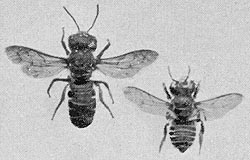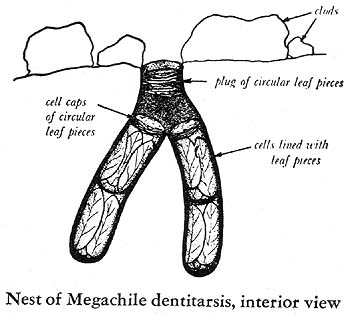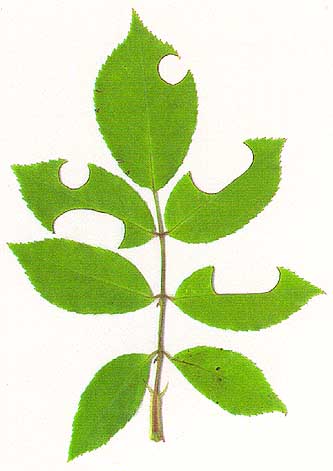
(from Howard 1903)
BUG OF THE MONTH: August 1996
Leaf-Cutter Bees
Order Hymenoptera, family Megachilidae (part)
Copyright © 1996 by Louise Kulzer
This article originally appeared in Scarabogram, August 1996, New Series No. 196, p. 3.
 |
| Two species of Megachile (from Howard 1903) |
I always like late spring and summer, because as soon as my roses start looking good, I can be pretty sure the leaf-cutter bees are not far behind. Leaf-cutter bees are solitary bees in the family Megachilidae (but remember, not all megachilids cut leaves). Those that do cut leaves use them to line their nests, which are constructed in a variety of places, such as tunnels in the ground, under stones, in the pith of brambles (Frost 1959) or excavated in wood.
[Most megachilids use pre-existing holes and do not dig their own burrows. Of 20 genera in the Pacific Northwest, three (Trachusa, most Megachile, some Hoplitis) use leaf pieces and many Osmia (a large genus also including the mason bees) use chewed-up leaf (Stephen et al. 1969).]

Actually, it's a bit more elaborate than just lining the nest burrow. Leaf-cutter bees construct several cells from the leaf pieces they collect. The cells are positioned end to end in a long burrow. Several circular leaf pieces form the bottom, then oblong pieces are placed along the sides to form a "thimble." This thimble is then provisioned with nectar and pollen, and an egg is laid in it. Then the bee cuts more circular pieces to close the cell. Once the cell is closed, the bee starts another cell above the first, until the whole cavity is filled. Like all solitary bees, the female leaves the nest after it is closed. The grubs fend for themselves on the nectar and pollen.
The adult leaf-cutter bee is smaller than a honey bee, dark, often hairy, with a prominent pollen basket below. Females are workaholics, and are a delight to watch because, being so intent on cutting leaves, they usually ignore a nearby observer! The leaf sections are cut with the mandibles, and the bee forms an arc with her head along the leaf edge to make the circular shape. (They remind me a little of an electric can opener, only with much more personality.)
 |
| Leaf-cutter bee damage on rose. Note both oval and circular cuts. |
Leaf-cutter bees are most notorious for cutting circular and oval holes in rose leaves, but I have seen them gather Hypericum sp. (St. John's wort), and this year they are particularly attracted to my vine maple. None of these plants are in the same family either, so that's not it. I think they choose plants that have a specific texture and thickness, much as one might choose paper of a certain weight for a report cover. It would be interesting to compare observations, fellow Scarabs!
Next time you see round or oval holes in your rose leaves, notice if they are regular and neat in outline (rather than ragged, like beetle damage is). If so, don't be dismayed. Just wait quietly and you may be rewarded by seeing first-hand the efficient, elegant work of the leaf-cutter bee.
References
Frost, S.W. 1959. Insect Life and Insect Natural History. Dover Publications, NY.
Stephen, W.P., G.E. Bohart, & P.F. Torchio. 1969. The Biology and External Morphology of Bees, With a Synopsis of the Genera of Northwestern America. Agricultural Experiment Station, Oregon State University, Corvallis.
This page last updated 16 June, 2005